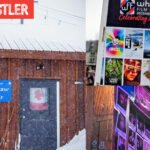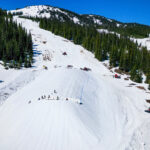What goes around, comes around in the ownership and management of ski resorts.
Winter 2015 .. My mind is a lot less cluttered now that I don’t have little resorts in the East that I have to travel to,” chuckles Charlie Locke, owner of Lake Louise Ski Resort. Locke’s business career almost embodies the serpentine course of the ski resort sector’s business structuring.
Our concerns as skiers typically don’t extend much beyond the price of lift tickets and lunch, and whether a competing resort’s deals might have been even better. But since most ski resorts aren’t owned by governments, if the lifts are going to keep turning so we can have our fun, the companies that operate them need to be viable businesses. And if their lifts and other infrastructure are going to be renovated or replaced as they wear out, the companies need to be profitable. So is there a best way to structure ski resorts?
Early in my career I wrote one of my first big business magazine features about the “transformation” of the ski industry, as embodied by Intrawest Corp. and its anchor resort, Blackcomb Mountain. Ski resorts, the story predicted, had only one future: as cogs in a multi-resort corporate wheel deploying vast capital investment in pursuit of continual, real estate-fuelled growth. That prediction was amply borne out for more than a decade.
Yet in the end, it was spectacularly wrong. Single-hill, individual proprietors like Locke survived and even thrived. So did the family-business ownership approach. As has a third model, the local businessperson-shareholder-operator group. What happened?
Intrawest, Vail Resorts Inc., and other big U.S. and European corporate ownership groups seemed to have found a winning formula, almost a financial elixir to transform the formerly thankless task of running lifts into a cash-generating machine profitable enough to captivate international stock market investors. The new approach was showing Canada’s rickety, archaic, under-capitalized, slow-moving and largely unprofessional ski resort sector how to do things. By meshing on-mountain improvements with continuous real estate development, Intrawest had created a “symbiosis” of almost automatic growth. More lifts brought more skiers, who needed more places to stay, which spurred housing construction, which generated bigger crowds, which justified building more lifts and other amenities. As the company continued buying ski resorts in Canada, the U.S. and France, it was soon dubbed “Intraworld,” reflecting a mix of awe and resentment at its incredible growth and seemingly limitless future.
It was the wave of the future. Other resorts needed to consolidate and adopt this model, or face takeover or even bankruptcy. Intrawest grew, swallowing Blackcomb’s one-time competitor Whistler, owned by a prominent Vancouver business family. If even they couldn’t withstand the corporate giant, then the crotchety eccentrics, local families, volunteer committees and clubs surely would be swept aside by the merciless tides. Some resort owners responded by becoming mini-aggregators, mimicking the Intrawest model on a regional scale. Locke was among them, buying up Nakiska, Wintergreen, Fernie, Kimberley and the Quebec City area resorts Stoneham and Mont-Sainte-Anne, as well as plunging into real estate development.
I should have known anything that certain was bound to be wrong. Eventually, the Intrawest model ran out of steam and its many ski resort holdings, including its crown jewel Whistler Blackcomb, were sold to Fortress Investment Group, an American private equity firm. Fortress in turn has had to sell off half of its acquired resorts, including Whistler Blackcomb, but that’s another story.
Some of the mini-conglomerates fared no better, while recent additions to the new resort model, like Revelstoke, hit the financial wall. The business model that had depended on continual real estate-fuelled growth no longer seemed ingenious. The relationship among lifts, skier-traffic and overnight bed numbers wasn’t so much a symbiosis as a headlong rush with no destination.
Suddenly it no longer seemed so dumb to be a single-owner running one ski hill. This approach lets the business focus purely on getting the lifts open on time, doing a good job of grooming and snowmaking, running a ski school, flipping burgers at lunch and giving skiers a nice day’s experience at a decent price. Where the skiers themselves come from is irrelevant. Hotels empty or full? Half-built condos not selling? Someone else’s problem. Day-trippers driving past the Vacancy signs are no longer a foregone opportunity to fill hotel beds—they’re the core market.
“A single-area business, if it’s the right size, can do very well, and our current business model works,” asserts Locke. “Real estate is a treadmill, and you either keep developing or you die.” Six years after the crash of late 2008, he says, “The non-skiing-focused corporate operators are basically gone.” Owning a group of resorts, Locke allows, does offer advantages in marketing, equipment sharing, deploying key talent where it’s needed and reducing cutthroat lift ticket price competition. But these aren’t always decisive. “When I had my group of resorts, Lake Louise itself made the majority of the profit,” Locke confides. “If a pure, single-resort skiing operation is of the right size, it can generate enough cash not only to live into next season, but to replace its capital assets over time.” Locke has plans for $35-$40 million in improvements to Lake Louise.
Another successful ownership model is built around a group of experienced business people, generally drawn from the surrounding region, their personal careers bringing numerous areas of expertise to the ski resort, and collectively wielding a substantial amount of capital. Panorama Resort near Invermere, B.C., is structured that way. That’s probably a good thing because the resort’s more isolated location required a different approach from Locke’s. “In Panorama’s case, there was the need to create a mountain resort town that was separate from the infrastructure of an existing town: sewer, water, roads, housing, hydro…” explains Steve Paccagnan, Panorama’s president and CEO. “That’s no longer a day area. That’s a destination.”
Panorama also reflects the gigantic market “correction,” i.e., downturn, in resort real estate that started in 2008. Put simply, the resort has a strong bed base, but is going deliberately slow on new real estate while focusing on excellence in the “core product,” the skiing. “We benefit from proximity to our core Alberta market, plus the passionate homeowner community,” says Paccagnan. “The company’s business model reflects entrepreneurship, inclusiveness and a passionate group of businesspeople who’ve structured the business in a way that provides good governance, while still being able to move quickly in terms of decision-making, which we feel is a competitive advantage.”
Panorama recently conducted a “re-envisioning” of the resort with multiple stakeholders, while carrying out various on-mountain improvements, including glading and “refreshing” some of the best terrain, like Taynton Bowl. Not being part of a multi-resort corporate group, says Paccagnan, “means that companies like ours need to be conscious of our capital, focusing on projects that are related to the core product and give us the best return on our investment and effort, maximizing utilization of our existing assets and being creative in making any new investment go a long way.”
“There’s no magic formula for resort ownership, because there’s such tremendous variety from area to area,” says Don Murray, vice-president of Ecosign Mountain Resort Planners Ltd. in Whistler. Ecosign conducts an annual economic survey for the Canada West Ski Areas Association. “Given the right market, a medium- to large-sized stand-alone ski area can make it. But for the stand-alone ski area, proximity to a large city is critical. If you’re isolated, you simply must build a bed base. Some ski areas would be sunk without that bed base, and although building the bed base may not be profitable, the bed base makes the skiing operations profitable.” And that means real estate development, despite the costs and risks. It may seem surprising, says Murray, “but ski area operations will outperform real estate over a 20-year period many times over.”
Meanwhile, the family-business approach that used to govern places like Whistler never died out. Another variant is a group of outsiders who happen to be successful businesspeople in other fields, and are primarily united by their love of skiing, purchasing a ski area. That’s what happened to Whitewater near Nelson, B.C., several years ago, and the ski hill was promptly expanded. Still another is a non-local entrepreneur who is charmed by an area buying the local ski hill and working to advance a common vision, which is what occurred at Red Mountain in Rossland, B.C. Down in the U.S., there’s been a major churn in ownership in the past couple of years in states like Utah and Colorado.
Even the multi-resort corporate model still works well under the right circumstances, Murray says. The previous era had suffered from huge over-capitalization due to an “arms race” of excessive growth among several resort corporations. That’s over with. Today, they’re focused on operating profitably. Large corporate owners not only have the capital to maintain modern infrastructure, they wield the pooled talent to get things done efficiently, not least navigating the often Byzantine regulatory processes for new terrain and lift approvals. U.S.-based Vail Resorts is perhaps the most successful example of this model. It has been buying up resorts and investing in on-mountain improvements. But it now seems clear that this is just one approach among several, workable in some cases, unviable in others. And no longer the wave of the future.



